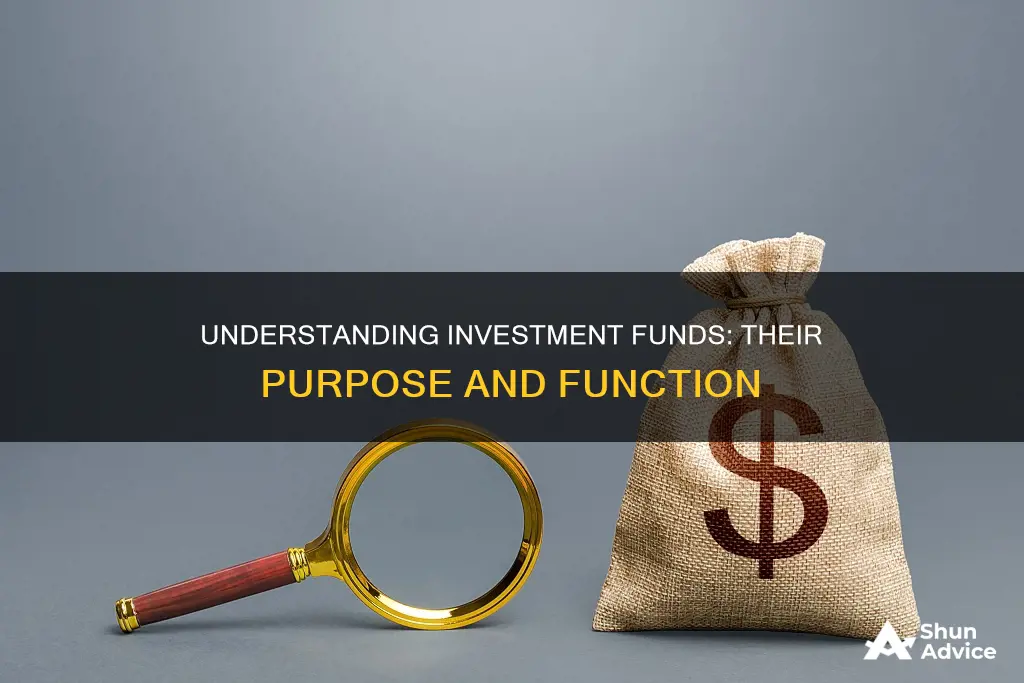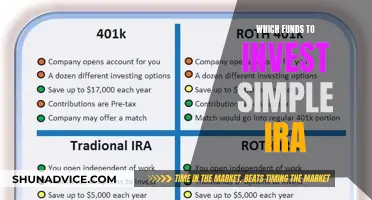
Investment funds are a way for investors to pool their money together to purchase securities, such as stocks and bonds. They are a popular option for investors as they allow for greater diversification, lower fees, and access to a wider range of investment opportunities. Investment funds are also beneficial as they allow investors to spread the risk of investing by investing in a range of assets. There are different types of investment funds, including mutual funds, exchange-traded funds (ETFs), money market funds, and hedge funds, each with its own advantages and disadvantages.
| Characteristics | Values |
|---|---|
| Purpose | To pool money from investors to purchase securities |
| Investor control | Investors retain ownership and control of their shares |
| Benefits | Broader investment opportunities, greater management expertise, lower investment fees |
| Investor decisions | Individual investors choose a fund based on goals, risks, fees, etc. |
| Fund management | A fund manager decides which securities to hold, in what quantities, and when to buy/sell |
| Types | Mutual funds, exchange-traded funds (ETFs), money market funds, hedge funds |
| Open-end funds | Issue new shares as investors add money and retire shares as investors redeem |
| Closed-end funds | Trade similarly to stocks, with a fixed number of shares traded on an exchange |
| ETFs | Trade on exchanges and are priced and available for trading throughout the day |
| Unit investment trusts | Offered to the public only once when created; no professional investment manager |
What You'll Learn

Investment funds pool resources to buy a range of assets
Pooling resources also allows investors to benefit from economies of scale, such as lower transaction costs. Investment funds can increase asset diversification to reduce unsystematic risk. They give people access to markets they would otherwise struggle to invest in individually. They also help to diversify investments, putting investors' savings in the hands of investment managers who scan the market for the best opportunities to generate a profit.
Pooling resources in an investment fund can also reduce dealing costs. If one investor had to buy a large number of direct investments, the amount they would be able to invest in each holding is likely to be small. Dealing costs are normally based on the number and size of each transaction, so the overall dealing costs would take a large chunk out of the capital.
Pooling resources also reduces the requirement for investors to spend their own time investing. An investor that chooses to use an investment fund does not need to spend as much personal time making investment decisions, doing investment research, or performing actual trades. Instead, these actions and decisions are made by one or more fund managers.
Emerging Market Funds: Worth the Investment Risk?
You may want to see also

They allow investors to diversify their holdings
Investment funds allow investors to diversify their holdings by pooling their resources with those of other investors. This collective investment approach enables investors to access a wider range of financial assets and spread their risk across multiple investments.
For example, an individual with £1,000 to invest will have limited purchasing power on their own. However, when 5,000 such investors combine their capital, they collectively have £5 million to invest, giving them greater buying power. This allows them to invest in a broader array of financial assets, such as stocks, bonds, or other securities, and effectively diversify their holdings.
By pooling resources, investors can also split fund management costs and benefit from economies of scale, resulting in lower transaction costs and investment fees. Additionally, investment funds provide access to professional investment managers, who can offer better returns and more adequate risk management. These managers select and monitor investments, deciding which securities to buy, sell, and hold, based on the fund's goals and strategies.
The diversification achieved through investment funds helps to reduce the overall investment risk. By investing in a variety of assets, the impact of any single investment's performance is diminished, as gains and losses are spread across the portfolio. This lowers the likelihood of significant losses and provides a more stable investment environment.
Different types of investment funds, such as open-ended and closed-ended funds, as well as actively and passively managed funds, offer investors a range of options to suit their investment goals, risk tolerance, and preferences. Actively managed funds are overseen by dedicated fund managers who aim to outperform a specific benchmark or index, while passively managed funds aim to mimic the performance of a particular market or index.
In summary, investment funds allow investors to diversify their holdings by pooling resources, accessing a wider range of assets, and benefiting from professional management and reduced costs. This diversification helps spread risk and provides a more stable investment approach.
Exploring Alternative Investment Funds in NPS
You may want to see also

Investment funds are generally considered lower risk
There are several types of investment funds, including mutual funds, exchange-traded funds (ETFs), money market funds, and hedge funds. Each investor retains ownership and control of their own shares. Investment funds provide a broader selection of investment opportunities, greater management expertise, and lower investment fees than investors might be able to obtain on their own.
With investment funds, individual investors do not make decisions about how a fund's assets should be invested. Instead, a fund manager oversees the fund and decides which securities it should hold, in what quantities, and when the securities should be bought and sold.
Investment funds can be actively or passively managed. Actively managed funds are overseen by a dedicated fund manager, who selects investments with the goal of outperforming a certain benchmark or index. Passively managed funds, on the other hand, aim to mimic the growth of a certain market by using a computer to track a specific index. These are often referred to as 'tracker funds'.
Actively managed funds tend to have higher management fees than passively managed funds, as they require more input.
While investment in a fund is generally considered lower risk, it is important to note that all investments carry a degree of risk and investors could lose money. Management fees can also eat into returns, particularly for actively managed funds.
Short Funds: Worth the Investment Risk?
You may want to see also

Investment funds are managed either 'actively' or 'passively'
Investment funds are a popular strategy for obtaining returns. They are a pool of capital from many investors that can be used to purchase a wide variety of securities. Investment funds are managed either actively or passively.
Actively managed investment funds involve a fund manager or a management team that makes decisions about how to invest the fund's money. They attempt to beat the market by picking and choosing investments. The manager performs an in-depth analysis of many investments to outperform the market index, like the S&P 500. Actively managed funds offer the opportunity to beat the market index, but they typically charge a higher fee, and many fail to beat the market consistently.
On the other hand, passively managed funds simply follow a market index. They do not have a management team making investment decisions. Instead, they mirror a particular index, such as the S&P 500. Passively managed funds tend to charge lower fees than actively managed funds, and they perform more consistently. However, the performance of a passively managed fund is, by definition, average.
Both types of funds have their advantages and disadvantages, and investors must decide which type better matches their investment style and objectives. Actively managed funds may be suitable for investors who want the potential to outperform the market, while passively managed funds offer a more consistent performance with lower fees.
It is important to note that the choice between active and passive management extends beyond mutual funds and exchange-traded funds (ETFs). Hedge funds, for example, are a type of investment fund that is typically actively managed. Additionally, the management style of an investment fund is just one factor to consider when choosing an investment fund. Investors should also consider their financial goals, risk tolerance, fees, and other factors to make an informed decision.
Mirae Asset Tax Saver Fund: Your Investment Guide
You may want to see also

Investment funds can be open-ended or closed-ended
Open-ended funds usually fall into one of two categories: open-ended investment companies (OEICs) and unit trusts. Although they are very similar, they are priced differently. Unit trusts are given two daily prices – a price for buying ('offer' price) and a lower price for selling ('bid' price) – while OEICs usually have a single daily price. For this reason, unit trusts are considered a longer-term investment as investors must wait for the fund's sell price to exceed the buy price they initially paid. OEICs are governed by company law, while unit trusts fall under trust law.
Closed-ended funds, on the other hand, have a limited number of shares instead of limitless units. These shares can be traded through a stock exchange in the same way as company shares. The price of each share in a closed-ended fund is decided by supply and demand, so it does not necessarily reflect the value of the fund's underlying assets. Investment trusts are a common type of closed-ended fund.
Closed-end funds have a fixed number of shares offered by an investment company through an initial public offering (IPO). After the IPO, shares are listed on an exchange. Investors can purchase shares through a brokerage firm on the secondary market. They can be traded at any time of the day when the market is open. They can't take on new capital once they have begun operating, but they may own unlisted securities in the U.S.
Open-end funds do not have a fixed number of shares and are offered through a fund company that sells shares directly to investors. There is no limit to how many shares an open-end fund can offer, meaning shares are unlimited. Shares will be issued as long as there is demand for the fund. So when investors buy new shares, the fund company creates new, replacement ones.
Prices for open-end funds are fixed once a day at their net asset value (NAV) – the fund's assets minus its liabilities – and reflect the fund's performance. This is the only price at which fund shares can be purchased that day.
The majority of investment fund assets belong to open-ended funds. However, closed-ended funds are more likely than open-ended funds to include alternative investments in their portfolios, such as futures, derivatives, or foreign currency.
International Funds: Diversify Your Portfolio, Gain Global Exposure
You may want to see also
Frequently asked questions
An investment fund is a way of investing money with other investors to benefit from the advantages of working as a group, such as reduced investment risk and lower transaction costs.
There are several types of investment funds, including mutual funds, exchange-traded funds (ETFs), money market funds, and hedge funds.
Investment funds pool money from multiple investors to purchase a diversified portfolio of stocks, bonds, or other securities. The fund is then managed by a professional fund manager who decides which securities to buy and sell.
Investing in funds offers several advantages, including diversification, reduced costs, access to expert management, and exposure to new markets. However, there are also potential drawbacks, such as management fees, limited investment control, and the risk of losing money.







